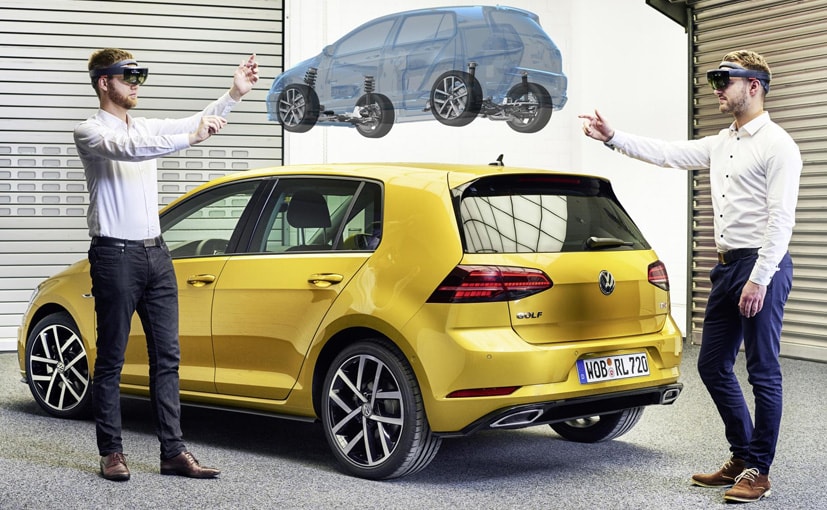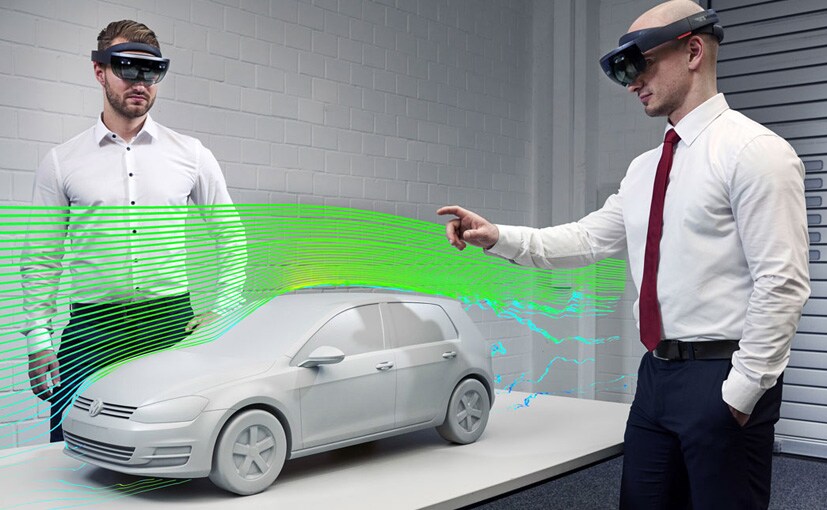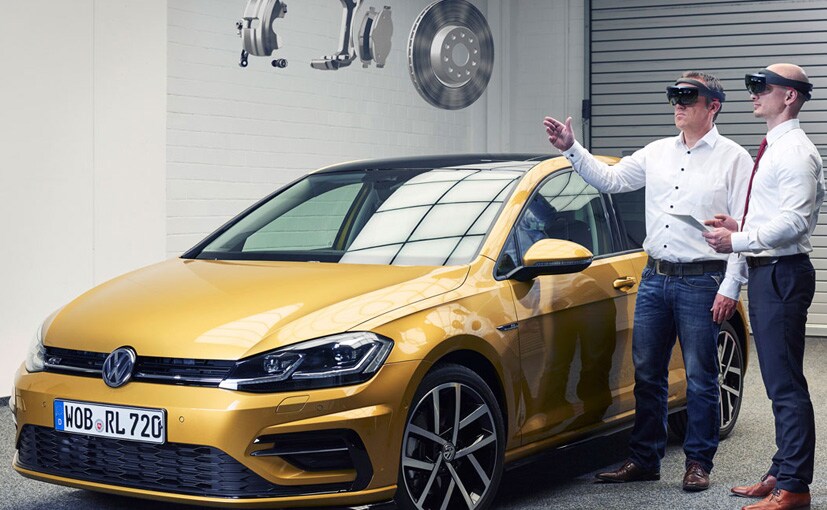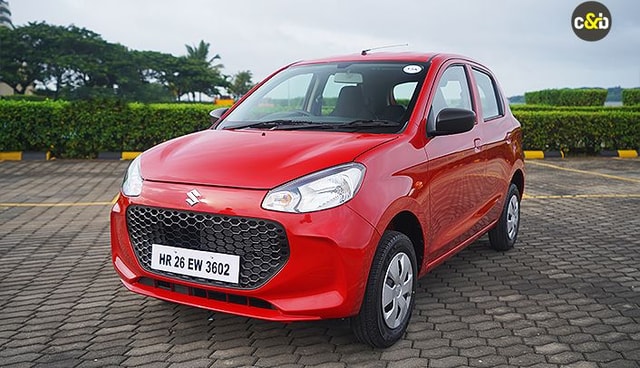Here's How Volkswagen Is Developing Future Products Virtually

- The HoloLens technology helps in creating a virtual projection
- The mobile computer developed by Microsoft projects virtual content
- Augmented and virtual reality help save time and development costs
The engineers wear mixed-reality goggles which help project their design onto a 1:4 scale model of a VW Golf and by the usage of gestures or even voice commands, they can change anything from the wheels, to the paint scheme to even the body shape of the car. Volkswagen's Virtual Engineering Lab is in Wolfsburg and computer engineer Frank Ostermann is leading one of six labs operated by Volkswagen Group IT that are utilising the virtual technology.

He said that engineers will soon be able to use the software to test physical workings of a virtual vehicle, rather than it being used solely for aesthetic design. The mobile computer developed by Microsoft projects virtual content onto a physical object through gesture control and voice commands. Ostermann only needs to point his finger and the HoloLens projects a different paint color onto the Golf, installs different wheels and modifies the fenders.
"At Volkswagen, we have been using augmented reality and virtual reality for some time, mainly to obtain a three-dimensional view," says Ostermann. "We are now taking a major step forward at the Virtual Engineering Lab. We are transforming this technology into a tool for Technical Development. This will allow Volkswagen engineers to work on a virtual vehicle, to change its equipment as they wish and even to design new components virtually. They will be able to see the results of their work immediately."

The HoloLens not only projects each design or equipment change directly onto the physical model. It also allows several project teams to work at the same time but at different places, for example teams from Wolfsburg, Chattanooga and Shanghai. Currently, the HoloLens software is still in the trial phase. In future, it will allow users to call up the entire Volkswagen brand model portfolio and to present different body versions of a model in all conceivable variants: the developers will then be able to transform a saloon virtually into an SUV, an estate car, a convertible or a coupe.
But Volkswagen isn't the only company using the virtual reality platform. Ford in fact has been at it for a long time and the development of the new generation of the Mustang, especially the cabin, was all thanks to the use of augmented reality. Everything from the gear knob to the design of the dashboard was ironed out with the use of virtual reality. Ford has admitted that using this technology has helped it get the car to the market faster, which just goes to show that the implementation of this technology really works.
Latest News
 Jaiveer Mehra | Jan 2, 2026New Kia Seltos vs Tata Sierra: Pricing ComparedKia has come out all guns blazing with the second-gen Seltos, with prices starting barely Rs 20,000 higher than the outgoing model. But how does it compare to the other newcomer in the segment, the Tata Sierra?5 mins read
Jaiveer Mehra | Jan 2, 2026New Kia Seltos vs Tata Sierra: Pricing ComparedKia has come out all guns blazing with the second-gen Seltos, with prices starting barely Rs 20,000 higher than the outgoing model. But how does it compare to the other newcomer in the segment, the Tata Sierra?5 mins read Bilal Firfiray | Jan 2, 2026BYD Records 4.6 Million Global Sales in 2025; EV Deliveries of 2.26 Million Could Top TeslaBYD hit 4.6 million sales in 2025 but saw its slowest growth in 5 years. Overseas deliveries crossed 1 million, while 2.26 million EV sales could push it past Tesla for the first time.2 mins read
Bilal Firfiray | Jan 2, 2026BYD Records 4.6 Million Global Sales in 2025; EV Deliveries of 2.26 Million Could Top TeslaBYD hit 4.6 million sales in 2025 but saw its slowest growth in 5 years. Overseas deliveries crossed 1 million, while 2.26 million EV sales could push it past Tesla for the first time.2 mins read Hansaj Kukreti | Jan 2, 2026No More KYV: Relief for FASTag Users from February 2026From February 1, 2026, NHAI will discontinue the KYV process for all new FASTags.1 min read
Hansaj Kukreti | Jan 2, 2026No More KYV: Relief for FASTag Users from February 2026From February 1, 2026, NHAI will discontinue the KYV process for all new FASTags.1 min read Bilal Firfiray | Jan 2, 2026Hyundai Venue HX5+ Variant Launched At Rs 9.99 LakhThe new HX5+ variant is available only with the Kappa 1.2-litre petrol engine with manual transmission. And the HX4 variant now gets driver seat height adjustment.1 min read
Bilal Firfiray | Jan 2, 2026Hyundai Venue HX5+ Variant Launched At Rs 9.99 LakhThe new HX5+ variant is available only with the Kappa 1.2-litre petrol engine with manual transmission. And the HX4 variant now gets driver seat height adjustment.1 min read Amaan Ahmed | Jan 2, 2026Maruti Suzuki Alto Leads Revival Of Entry-Level Car Sales For MSIL In December 2025With over 10,000 units of India's most affordable car sold in the final month of 2025, Maruti's entry-segment car sales rose to their highest point yet in FY25-26.1 min read
Amaan Ahmed | Jan 2, 2026Maruti Suzuki Alto Leads Revival Of Entry-Level Car Sales For MSIL In December 2025With over 10,000 units of India's most affordable car sold in the final month of 2025, Maruti's entry-segment car sales rose to their highest point yet in FY25-26.1 min read car&bike Team | Jan 2, 20262026 Kia Seltos Launched In India At Rs 10.99 LakhOffered in 10 variants across three engine options, the second-generation Kia Seltos finally goes on sale in India.4 mins read
car&bike Team | Jan 2, 20262026 Kia Seltos Launched In India At Rs 10.99 LakhOffered in 10 variants across three engine options, the second-generation Kia Seltos finally goes on sale in India.4 mins read
 Preetam Bora | Dec 30, 2025TVS Orbiter Review: Real-World Performance and Range TestedThe TVS Orbiter is a promising electric scooter promising decent range, practicality and pricing. But is there any reason to avoid it? We spent a few days getting to know it better.9 mins read
Preetam Bora | Dec 30, 2025TVS Orbiter Review: Real-World Performance and Range TestedThe TVS Orbiter is a promising electric scooter promising decent range, practicality and pricing. But is there any reason to avoid it? We spent a few days getting to know it better.9 mins read Jafar Rizvi | Dec 24, 2025MG Windsor EV 38 kWh Long-Term Report: IntroductionThe Windsor EV has joined our garage, and before it settles into daily duty, I took it out to get a sense of what living with an electric car is like.4 mins read
Jafar Rizvi | Dec 24, 2025MG Windsor EV 38 kWh Long-Term Report: IntroductionThe Windsor EV has joined our garage, and before it settles into daily duty, I took it out to get a sense of what living with an electric car is like.4 mins read Seshan Vijayraghvan | Dec 23, 20252026 Kia Seltos Review: Formula Is Spot On, But Is The Timing Right?The 2nd-gen Kia Seltos has arrived, but it has the challenge of facing strong rivals like the Victoris and Sierra. The question is simple - Does it still have what it takes?9 mins read
Seshan Vijayraghvan | Dec 23, 20252026 Kia Seltos Review: Formula Is Spot On, But Is The Timing Right?The 2nd-gen Kia Seltos has arrived, but it has the challenge of facing strong rivals like the Victoris and Sierra. The question is simple - Does it still have what it takes?9 mins read car&bike Team | Dec 26, 2025Tata Punch EV Long-Term Second Report: Highway Performance, Pros & ConsAfter a week of living with the Tata Punch EV Long Range—including a proper Mumbai-Nashik highway test—we've learned what this little electric SUV is really made of.1 min read
car&bike Team | Dec 26, 2025Tata Punch EV Long-Term Second Report: Highway Performance, Pros & ConsAfter a week of living with the Tata Punch EV Long Range—including a proper Mumbai-Nashik highway test—we've learned what this little electric SUV is really made of.1 min read Seshan Vijayraghvan | Dec 22, 20252026 Tata Harrier & Safari 1.5 Hyperion Review: By The Power Of Petrol!The new Tata Harrier and Safari petrol packs a new 1.5-litre TGDI Hyperion engine, but is it an ideal alternative to the diesel version?7 mins read
Seshan Vijayraghvan | Dec 22, 20252026 Tata Harrier & Safari 1.5 Hyperion Review: By The Power Of Petrol!The new Tata Harrier and Safari petrol packs a new 1.5-litre TGDI Hyperion engine, but is it an ideal alternative to the diesel version?7 mins read






















































































































